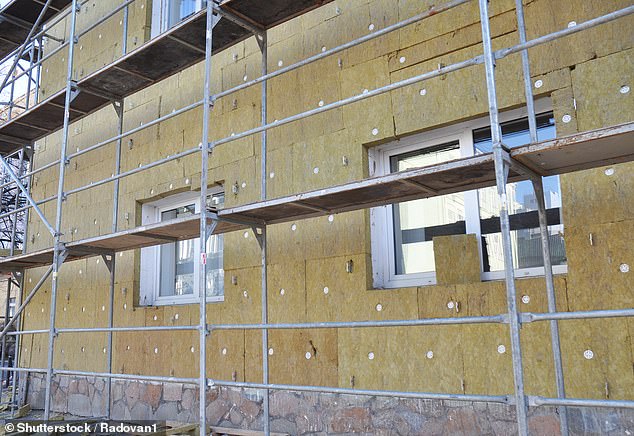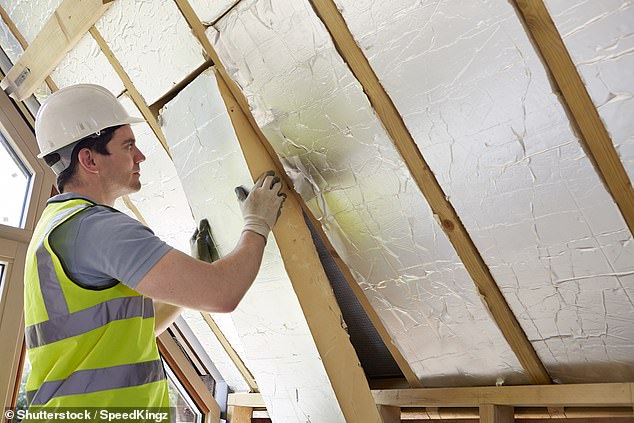How much does wall and loft insulation cost? Our guide to making your house warmer and cutting bills
>
If you want to make your home as efficient as possible and reduce energy bills, there is no substitute for professional insulation.
Hiring an expert to install heat-saving material in your home involves an upfront cost that can run into the thousands of dollars, but it’s one of the best long-term investments you can make.
And these improvements not only make your home cheaper to heat, but can also increase its value.
According to Bloomberg Intelligence, a home’s energy efficiency is now considered important or very important by nearly nine in ten buyers.
Here are some of the best ways to reduce energy bills by insulating your home.
Having your home insulated by professional craftsmen means more comfortable winters and lower energy bills for life
Wall insulation – save up to € 1,800 per year
If you’re serious about stopping your home’s heat loss, you need to tackle the walls.
According to insulation experts LoftZone, about 35 percent of heat leaves buildings through the walls — more than any other surface, including the roof. The National Insulation Association puts this figure even higher at 45 percent.
And, as LoftZone’s Dave Raval points out, insulation works in two ways. It helps keep you warm in the winter and cool in the summer.
The latter has never been a real selling point in the UK as traditionally our summers don’t get hot enough for that to matter much.
But if the 40-degree heat wave in 2022 becomes more common in the future, insulation will become a greater benefit year-round, not just in winter.
There are two main types of wall insulation, depending on the type of wall you have: solid walls or cavity walls.

Outer Layer: External insulation is applied to the exterior walls of properties to keep heat inside
Solid Wall Insulation – Saved £240 to £930 per year
Homes built before 1920 are likely to have solid brick walls. These can be insulated and that insulation can come on the inside or outside of the wall.
External insulation involves applying insulation material and then plastering or covering it. Interior insulation is usually a form of thermal siding applied to interior walls. This will reduce the size of the room when installed.
The cost of insulating the outside of a three-bedroom semi-detached house is around £12,000, or £8,500 if done inside, according to the Energy Saving Trust charity.
However, that then leads to a big drop in energy bills – £240 a year for a mid-floor apartment to £930 a year for a detached house.

Indoors: Indoor insulation either involves installing special boards, such as this one, or using rock wool
Cavity wall insulation – £395 to £1,800 saved per year
Usually found in more modern homes, cavity walls have an air-filled opening in the middle of two walls. The idea of cavity walls is to protect interior walls from moisture, and the air gap provides a slight insulating benefit.
But that advantage can be improved by installing good insulation. This is done by having a professional drill small holes in the wall and then spray insulation into the cavity, usually foam, polystyrene beads or mineral wool.
Around eight million homes in the UK now have this type of insulation. But there can be serious problems if it is not installed correctly.
Last year we reported that up to two million homeowners are having problems with cavity wall insulation. In some extreme cases, the resulting damp and mold problems in the homes rendered them worthless and unsaleable.
About six million homes have had cavity wall insulation installed by professionals with the support of the Spouw Insulation Guarantee Office. It has a 25 year warranty.
Double glazing – save up to €235 per year
Double glazing not only helps to keep heat in, but also keeps noise and drafts out. Fitting these types of windows can save between £195 and £235 a year in energy bills.
But that entails upfront costs.
Installing double glazing with an A label in an average semi-detached house costs approximately € 7,500.
Attic Insulation – Saved £640 a year
A person living in a semi-detached house with no roof insulation could save £640 a year by installing 270mm of insulation in their attic, according to the Energy Saving Trust.
If you do this yourself it can cost £100 depending on the size of your hutch.
But if you choose to pay professionals to do the job, it could cost closer to £500 – still less than you’d save on utility bills within a year of the work being completed.
Floor insulation – save up to €110 per year
For houses with wooden floors, insulating your ground floor can reduce energy bills by more than £110 a year for the average home, or up to £180 for a detached house.
Those figures rise to £90 and £145 a year in Northern Ireland respectively, according to the Energy Saving Trust.
As with roof insulation, this involves lifting the floorboards and laying mineral wool insulation on top of the mesh between the joists.
Depending on the size of your ground floor, this could cost £100 if you do the work yourself, or from £1,600 to £2,900 if you have it done by a professional.
Some links in this article may be affiliate links. If you click on it, we may earn a small commission. That helps us fund This Is Money and use it for free. We do not write articles to promote products. We do not allow any commercial relationship to compromise our editorial independence.
